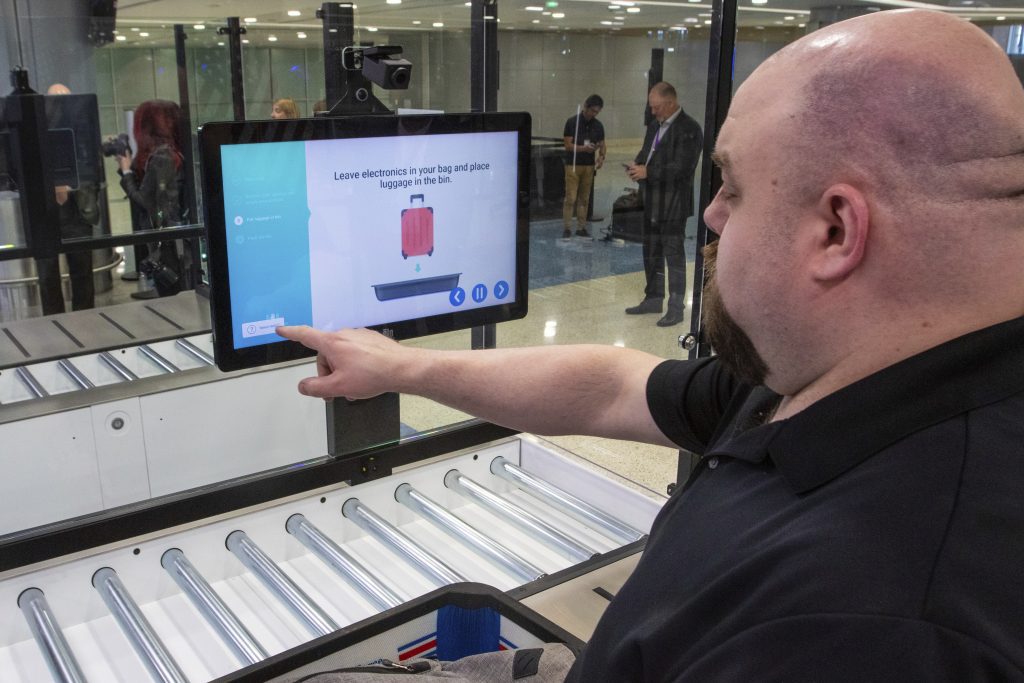LAS VEGAS — The Transportation Security Administration revealed a self-screening system for passengers at the busy Harry Reid International Airport in Las Vegas on Wednesday. However, they have no plans to implement it in other cities around the country.
“How can we move into the future? This is a step,” said Dimitri Kusnezov, a system designer and the science and technology under secretary at the U.S. Department of Homeland Security. “The interaction with people is crucial.”
The TSA checkpoint in Las Vegas, exclusively for TSA PreCheck customers and in English only, includes a screen with self-explanatory instructions guiding individuals on how to smoothly navigate pre-flight screening with their carry-on luggage, requiring minimal assistance from uniformed TSA officers.
“Our goal is to avoid passengers having to undergo pat-downs,” said John Fortune, the program manager of the Department of Homeland Security’s “Screening at Speed” program and a collaborator with Kusnezov on the prototype.
In place of the traditional belt-fed device with gray trays, the modern baggage and personal belongings inspection system bears a resemblance to a scaled-down medical magnetic resonance imaging machine, featuring an automated bin return belt.
Travelers enter a separate transparent body scanning booth with an internal video display illustrating the standing position necessary for being sensed using what officials described as the “millimeter wave technology” already in use across the country. A journalist found it to be sensitive enough to detect a forgotten handkerchief in a pocket without requiring him to remove his shoes.
“Ultimately, one of the primary objectives here is to enable individuals to pass through the system without needing direct interaction with an officer and … at their own pace,” stated Christina Peach, a TSA administrator involved in the system design. “It’s also about avoiding feeling rushed.”
According to agency spokesman R. Carter Langston, almost all passengers enrolled in the TSA PreCheck program nationwide clear screening in ten minutes or less, while regular traveler and carry-on screening takes about 30 minutes.
Peach mentioned that the new system may require eight uniformed TSA officers to operate two lanes, as opposed to the 12 officers in current lanes.
However, Kusnezov and Karen Burke, TSA federal security director in Nevada, mentioned that agents, including union members, would be relieved from hands-on screening to focus more on broader security concerns.
“No one is going to lose their job,” Burke assured.
Fortune declined to estimate the cost of developing the system, but he stated that the scanners used are similar to ones already in use across the country.
Authorities stated that they will measure the speed at which travelers pass through the prototype during evaluations this year.
Testing is taking place at a one-of-a-kind “innovation checkpoint” unveiled by TSA in 2019 at the expansive international arrivals terminal that opened in 2012 at Harry Reid airport. It already contains screening lanes equipped with instruction displays and estimated wait times.
Keith Jeffries, a former TSA director at Los Angeles International Airport and now vice president of K2 Security Screening Group, a company that installs screening systems at shipping ports including airports, said that this technology change is for people who want to pass through a checkpoint more quickly. He mentioned that it will be beneficial, but he expects it will be mainly used by experienced passengers.
In an interview with The Associated Press, Jeffries likened the new system to self-checkout lanes that became popular in the 1980s and are now common at supermarkets nationwide. He remembered that some shoppers initially avoided scanning their own purchases.
He expressed that it will require time to inform the public about the TSA screening lanes and said," You're going to have a new generation of travelers that just wants to get through with the least amount of hassle and delay. I think eventually we'll see more and more of them."
In 2022, Harry Reid International Airport was the seventh-busiest passenger airport in the U.S., according to Airports Council International, ranked behind New York's John F. Kennedy International Airport. In 2023, the Las Vegas airport handled a new record of 57.6 million arriving and departing passengers.
The Transportation Security Administration had its busiest day ever at the airport last month, screening nearly 104,000 travelers and their luggage as they headed for airline flights on Feb. 12, the day after the NFL Super Bowl was played at Allegiant Stadium.









